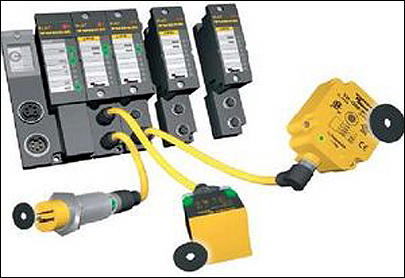Jun 11, 2007Turck, a manufacturer of products designed for factories and process automation, has introduced a new RFID-enabled system that makes it easier to manage and control machines running on the factory floor.
BLident is a modular RFID system that can be used to control a variety of machines, from a stamping press in an automotive assembly line to a conveyor system to a machine that makes chocolates. The system employs high-frequency (13.56 MHz) RFID tags and interrogators supporting the ISO 15693 standard.
Remote input/output (I/O) systems, wirelessly managed by a central programmable logic controller (PLC), have been available for some time. However, such devices can be difficult to manage because each slice (receiver) in an I/O system has to be programmed for a specific process and machine.
If the correct program hasn't been loaded into the receiver, explains Mark DiSera, Turck's RFID system product manager, processes might be performed out of sequence or machines may become damaged and broken. Turck, a global company based in Mulheim an der Ruhr, Germany, with 25 locations worldwide, has its U.S. headquarters in Plymouth, Minn.
Depending on the application, the RFID tags are placed either on the products themselves, or on the tooling. The I/O slice containing the RFID interrogator reads the tag's unique ID number, associated in a back-end system with the correct machine program. If it discovers a match between the tag number and the tool or process, the system allows the machine to begin its operation.
RFID tags are becoming more prevalent in automation, DiSera says. The tags are replacing bar codes, which, in some cases, have proven cumbersome. "During painting processes, the bar codes get covered, and then the bar code can't be read and the I/O [slice] can't determine which is the next process," he says. "Now, with RFID, the tag can be read whether or not there's a coat of paint on it."
Behr, a Stuttgart, Germany, supplier of heating and cooling systems to major auto manufacturers, started using the BLident RFID system this month on four machines involved in the construction of air conditioner evaporators. "These are four machines that perform the same operations, and share among them about 15 sets of tooling," says Mike Watkins, owner of Shires Engineering, a Dayton, Ohio, company specializing in controls engineering, programming, electrical components engineering and automation equipment services. "Because Behr's product line had gotten so large, it was hard to control which tooling goes with which product. The issue was, if you put in the wrong tool, you could crash the machine or assemble the wrong parts. Behr needed a failsafe system to make sure they didn't have the wrong tooling in."
Shires Engineering worked with C&E Sales, a Turck distributor also based in Dayton, to deploy the BLident system for Behr. The system has been working smoothly, Watkins reports.
The read range between the reader and the tag is about an inch-and-a-half, and in the event of an incorrect read, or no read at all, the system will display a fault message. "It won't even let you run the machine," he says. "Behr likes it so much, they plan to expand it." What's more, BLident is modular, enabling users to add additional I/O slices, while also allowing the addition of up to eight RFID channels or a variation of RFID and sensors.


